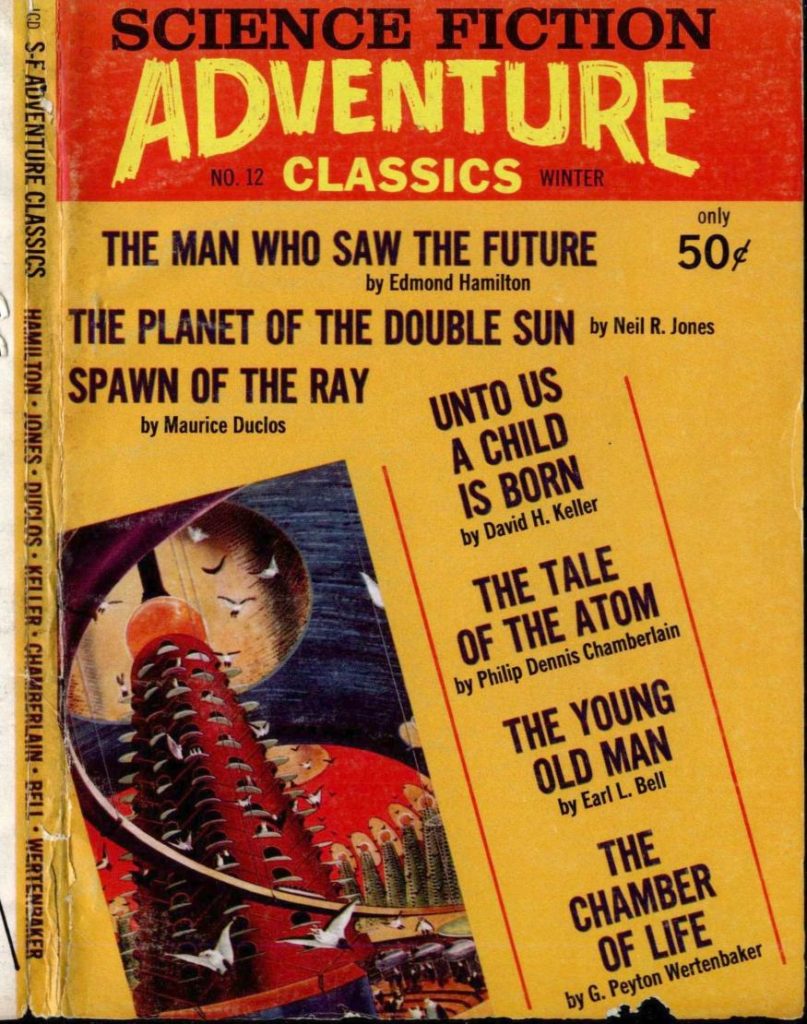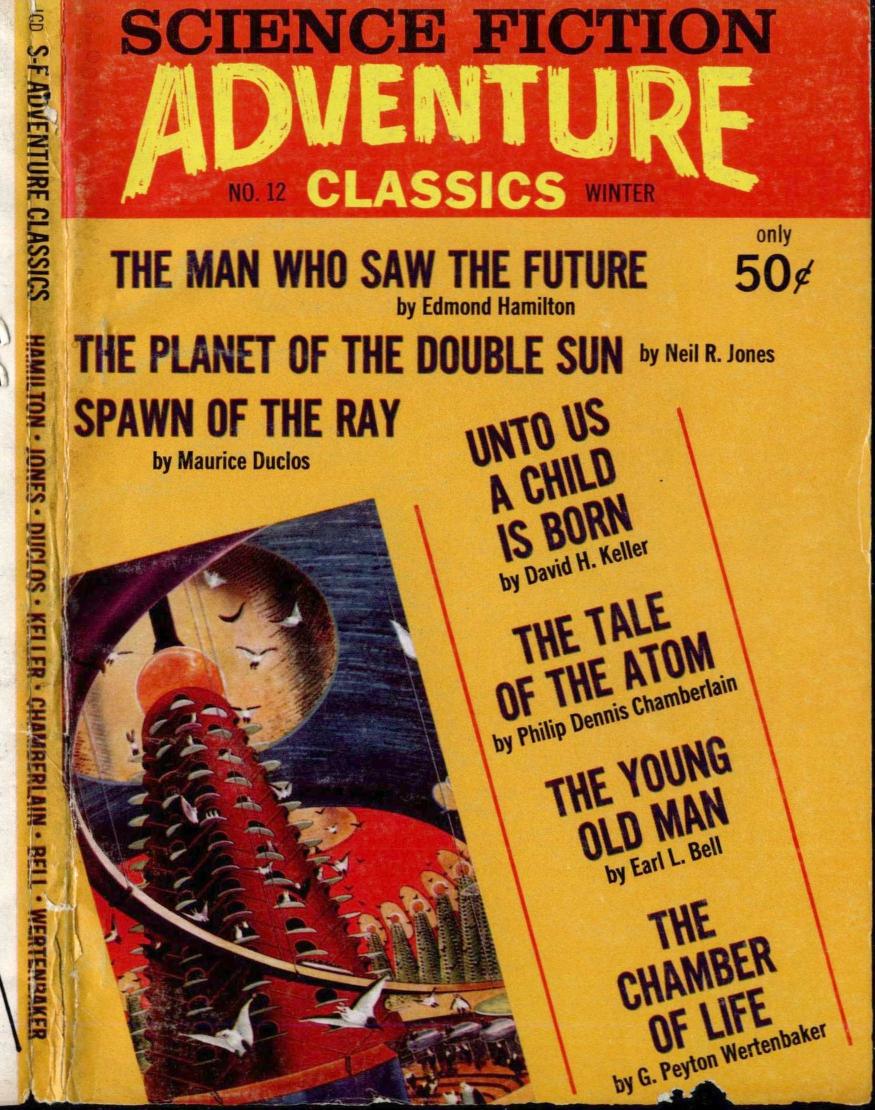Magazine Review: Science Fiction Adventure Classics #12 Winter edited by Sam Moskowitz
This is a magazine I could find very few details about. It reprinted 1920s and 1930s tales from Amazing Stories; it’s listed as quarterly, but seems to have been published on a more irregular basis. This issue is apparently from 1970 though there’s no publishing date in the issue itself. All the stories have introductions by Sam Moskowitz explaining their significance or expositing on the themes.

“The Man Who Saw the Future” by Edmond Hamilton opens the issue. A man from France in 1444 is pulled to the year 1944 by scientists who are experimenting with time travel. He sees many wonders in the future before returning to his home time. Henri is put to death for sorcery by the French Inquisition (historically dubious), but not before he gives a full account of his adventure.
This story was something of a comeback for Hamilton, who’d gotten typecast as a “world-threatening disaster” author and wanted to show he could write smaller-scope, more human stories. Published in 1930, it utterly fails to guess what would be going on in Paris in 1944.
“The Chamber of Life” by G. Peyton Wertenbaker is a 1929 story about what we’d now call virtual reality. A man wakes up in a lake with no memory of how he got there. After a short while, he remembers waking up in another world with no memory of who he was or why he was there. And then he starts remembering what happened last night.
It seems he’d met an inventor at his club, they got along well, and the inventor asked Mr. Barrett to try out his new invention. The effect is like an interactive movie impinging on all five known senses, and while under its effect, the story seems absolutely real. As a test run for the technology, inventor Melbourne has created a utopian society of the far future to explore.
As the amnesiac Baret, the protagonist is taken into the community of Richmond, a comfortable but highly regulated society. His guides are Edvar, a historian, and the beautiful Selda. Over the course of a couple of months, Baret falls in love with Selda, but alas her husband Edvar has already been chosen and there is no room in the society for Baret to fill.
The twist to the story is that Barrett is a sleepwalker, and during the course of the virtual reality scenario being beamed into his brain, he’s actually been wandering around town (probably Chicago but never named) and jumped in the lake at an appropriate moment. It’s also mentioned in passing that Melbourne was “playing” female love interest Selda, which raises some questions.
“Unto Us a Child is Born” by David H. Keller (1933) echoes the previous story by being set in a comfortable but highly regulated future society. Jacob Hubler is a member of that society who has proven his worth in the field of designing kitchen appliances. His genetic material is clearly superior, so he will now be allowed to marry and have a child. (With life expectancy now around 150 years, population control is a thing.) In fact, it initially seems his genetic material is unmatched.
But it turns out his female best friend is both genetically superior as well as somehow still available, and they are allowed to hook up. They have a son, who is raised by the best educators because of his super high potential. On the son’s first visit home at age 12, they realize he’s a stranger who is more interested in his work than in bonding. Mr. and Mrs. Hubler are offered the rare chance to have another child, but opt out.
As the introduction puts it, nothing unexpected or “bad” by their society’s standards happens to anyone in the story, but it’s very sad from a modern reader’s standpoint.
“The Planet of the Double Sun” by Neil R. Jones (1932) is the second of the “Professor Jameson” stories, and according to the introduction, where that series really took off with the readers. When Professor Jameson died in 1950, he had his body encased in a rocket, which was launched into a geosynchronous orbit around the Earth. Forty million years later, the now dying planet is visited by the Zoromes, aliens from the planet Zor who have placed their brains into superior mechanical bodies for effective immortality. The Zoromes find the satellite, realize Professor Jameson’s brain is still intact, and transfer it into a spare robot body. Time to explore the universe!
This story opens with the full-body cyborgs approaching a binary star system, the first that Professor Jameson (or as he’s known to his friends, “21MM392”) has gotten to see in person. There are four planets sharing an orange and a blue star. The Zoromes land on the first planet in the habitable zone, and begin exploring. They soon learn the place used to be inhabited by an intelligent triped species, which destroyed itself in apparent fits of madness.
When the blue sun is alone in the sky, it creates an eerie lighting effect. And soon the Zoromes find themselves driven to suicide and murder! Can they and Professor Jameson figure out what’s going on before they too are extinct?
While the answer to the riddle of the double sun is dubious science at best, and raises more questions than it explains, the story is very effective at emphasizing that for all their seeming invulnerability, the Zoromes are not immune to death and terror. This installment ends on a bit of a cliffhanger, but there were nineteen more stories in the series, so we know Professor Jameson makes it.
“Spawn of the Ray” by Maurice Duclos (1938) is a “creature feature” story of sorts. Science dabbler Benny Parker has too much to drink at the Science Club and heckles the invited speaker who’s an expert on evolution with the notion that “rays cause evolution.” Said expert is too angered to even respond coherently, and Benny is horribly embarrassed when he sobers up. (For those of you who might have forgotten high school science: radiation can cause mutations, and if those mutations are inheritable and favorable in the current ecosystem, they will passed on in the population as part of the evolutionary process. You can’t just whip up an “evolution ray.”)
Benny is determined to get back some respect, so sets up an experiment to subject flagel-lata (a lifeform that is on the boundary of plant and animal) to intense radiation in an effort to cause mutations that he can then write up and get fame for. He successfully induces gigantism and a taste for flesh, and these traits prove inheritable with a thousand spawn per breeding period.
Which is pretty impressive results. Alas, Benny is only a dabbler and does not follow standard containment protocols. The specimens escape into the wild, and soon there are reports of giant flagel-lata coming in from all over California. Benny decides his best bet is to flee to the mountains to avoid blame for this civilization-ending menace. His trip takes him through Los Angeles, which has become a madhouse.
About four months later, Benny emerges from his cabin for supplies, and finds out what happened to the giant flagel-lata menace. It was delicious.
“The Young Old Man” by Earl L. Bell (1929) is a riff on the theme of immortality. Two college students are fishing in the Ozarks when they run into a general store owner with strange eyes and an air of mystery about him. This story was a bit of a disappointment. We have one scene with the shopkeeper, another with a long-time resident deepening the mystery, and then the remainder of the story is the viewpoint characters reading the old man’s suicide note.
Apparently one of the side effects of this immortality method is a complete loss of sex drive.
“The Tale of the Atom” by Philip Dennis Chamberlain (1935) rounds out the issue with the tale of an alien scientist who’s developed an atom microscope; and also Earth in the far future when it’s discovered the sun is about to be destroyed. A brilliant scientist comes up with a way to save Earth, if not the sun itself, but then there’s a double twist. This one’s so-so.
The Hamilton and Jones stories are the best in the issue. I’m pretty sure everything Hamilton has been reprinted somewhere, and the majority of the Professor Jameson stories are available from Armchair Science Fiction. Overall, this is a decent collection of pulp science fiction, and Mr. Moskowitz’ introductions are of great benefit in connecting the stories to science fiction history. Good luck finding a copy!

